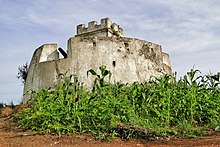
Fort Victoria is a structure in Cape Coast, Ghana. It was initially known as 'Phipps Tower', in honour of its initial constructor English Governor Phipps. Its name was changed later to Fort Victoria in honor of Queen Victoria. [1] Along with other nearby forts and castles, Fort Victoria was inscribed on the UNESCO World Heritage List in 1979 because of its European colonial significance. [2]